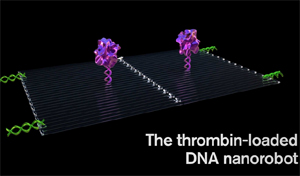



Date:13/02/18
 Science fiction no more — in an article out today in Nature Biotechnology, scientists were able to show tiny autonomous bots have the potential to function as intelligent delivery vehicles to cure cancer in mice.
Science fiction no more — in an article out today in Nature Biotechnology, scientists were able to show tiny autonomous bots have the potential to function as intelligent delivery vehicles to cure cancer in mice.
These DNA nanorobots do so by seeking out and injecting cancerous tumors with drugs that can cut off their blood supply, shriveling them up and killing them.
"Using tumor-bearing mouse models, we demonstrate that intravenously injected DNA nanorobots deliver thrombin specifically to tumor-associated blood vessels and induce intravascular thrombosis, resulting in tumor necrosis and inhibition of tumor growth," the paper explains.
DNA nanorobots are a somewhat new concept for drug delivery. They work by getting programmed DNA to fold into itself like origami and then deploying it like a tiny machine, ready for action.
The scientists behind this study tested the delivery bots by injecting them into mice with human breast cancer tumors. Within 48 hours, the bots had successfully grabbed onto vascular cells at the tumor sites, causing blood clots in the tumor’s vessels and cutting off their blood supply, leading to their death.
Remarkably, the bots did not cause clotting in other parts of the body, just the cancerous cells they’d been programmed to target, according to the paper.
The scientists were also able to demonstrate the bots did not cause clotting in the healthy tissues of Bama miniature pigs, calming fears over what might happen in larger animals.
The goal, say the scientists behind the paper, is to eventually prove these bots can do the same thing in humans. Of course, more work will need to be done before human trials begin.
Regardless, this is a huge breakthrough in cancer research. The current methods of either using chemotherapy to destroy every cell just to get at the cancer cell are barbaric in comparison. Using targeted drugs is also not as exact as simply cutting off blood supply and killing the cancer on the spot. Should this new technique gain approval for use on humans in the near future it could have impressive affects on those afflicted with the disease.
New DNA nanorobots successfully target and kill off cancerous tumors
 Science fiction no more — in an article out today in Nature Biotechnology, scientists were able to show tiny autonomous bots have the potential to function as intelligent delivery vehicles to cure cancer in mice.
Science fiction no more — in an article out today in Nature Biotechnology, scientists were able to show tiny autonomous bots have the potential to function as intelligent delivery vehicles to cure cancer in mice.These DNA nanorobots do so by seeking out and injecting cancerous tumors with drugs that can cut off their blood supply, shriveling them up and killing them.
"Using tumor-bearing mouse models, we demonstrate that intravenously injected DNA nanorobots deliver thrombin specifically to tumor-associated blood vessels and induce intravascular thrombosis, resulting in tumor necrosis and inhibition of tumor growth," the paper explains.
DNA nanorobots are a somewhat new concept for drug delivery. They work by getting programmed DNA to fold into itself like origami and then deploying it like a tiny machine, ready for action.
The scientists behind this study tested the delivery bots by injecting them into mice with human breast cancer tumors. Within 48 hours, the bots had successfully grabbed onto vascular cells at the tumor sites, causing blood clots in the tumor’s vessels and cutting off their blood supply, leading to their death.
Remarkably, the bots did not cause clotting in other parts of the body, just the cancerous cells they’d been programmed to target, according to the paper.
The scientists were also able to demonstrate the bots did not cause clotting in the healthy tissues of Bama miniature pigs, calming fears over what might happen in larger animals.
The goal, say the scientists behind the paper, is to eventually prove these bots can do the same thing in humans. Of course, more work will need to be done before human trials begin.
Regardless, this is a huge breakthrough in cancer research. The current methods of either using chemotherapy to destroy every cell just to get at the cancer cell are barbaric in comparison. Using targeted drugs is also not as exact as simply cutting off blood supply and killing the cancer on the spot. Should this new technique gain approval for use on humans in the near future it could have impressive affects on those afflicted with the disease.
Views: 522
©ictnews.az. All rights reserved.Similar news
- The mobile sector continues its lead
- Facebook counted 600 million active users
- Cell phone testing laboratory is planned to be built in Azerbaijan
- Tablets and riders outfitted quickly with 3G/4G modems
- The number of digital TV channels will double to 24 units
- Tax proposal in China gets massive online feedback
- Malaysia to implement biometric system at all entry points
- Korea to build Green Technology Centre
- Cisco Poised to Help China Keep an Eye on Its Citizens
- 3G speed in Azerbaijan is higher than in UK
- Government of Canada Announces Investment in Green Innovation for Canada
- Electric cars in Azerbaijan
- Dominican Republic Govt Issues Cashless Benefits
- Spain raises €1.65bn from spectrum auction
- Camden Council boosts mobile security





















